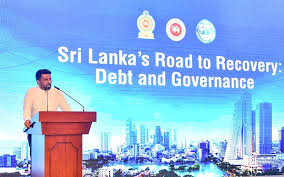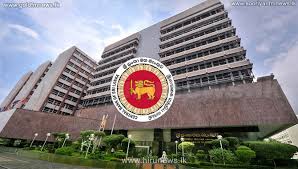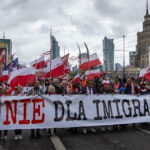
Sri Lanka’s Road to Recovery Hampered by Debt, Tariffs and Global Uncertainty
- CNL Reporter
- July 19, 2025
- Weekly Economic Review
- Tariffs
- 0 Comments
WEEKLY ECONOMIC REVIEW
Sri Lanka’s journey toward economic stability remains fragile, with both domestic structural challenges and international headwinds weighing heavily on its progress. Despite recent gains acknowledged by the International Monetary Fund (IMF), the government faces an uphill battle in securing sustainable growth, managing foreign debt obligations, and improving the standard of living for the majority of its citizens.
The IMF has expressed cautious optimism about Sri Lanka’s reform agenda and fiscal progress. However, its primary concern remains the sustainability of the country’s external debt. For Sri Lanka to remain on a serviceable debt path, consistent economic growth is critical. Yet, such growth faces stiff resistance from rising geopolitical uncertainties, most notably the fallout from escalating U.S. trade policies under President Donald Trump.
The impact of Trump-era tariffs—now reemerging as a major force in global trade politics—has already begun to affect Sri Lankan exporters. Sri Lanka had initially hoped to negotiate a significant reduction in U.S. tariffs, aiming to bring them down from 44% to around 10%.

However, the final outcome was disappointing, with a 30% tariff imposed starting August 1, 2025, and an additional 12% under the Most-Favoured Nation (MFN) rate. This effectively shuts the door on further negotiations and leaves Sri Lankan exporters grappling with competitiveness issues in one of their key markets.
With limited options to revisit U.S. trade terms in the near term, Sri Lanka may be compelled to pivot towards alternative markets in Asia and Africa. However, such trade realignments require time, new logistics frameworks, and deeper bilateral ties—none of which can offer immediate relief.

At the heart of Sri Lanka’s economic conundrum is its external financial position. According to the Central Bank, the country recorded a financial account deficit of $610 million, largely driven by continued debt repayments and efforts to build foreign reserves. These outflows are sometimes misconstrued as “capital flight,” but in practice, they reflect necessary fiscal discipline aimed at restoring market credibility.
To fund these repayments and bolster reserves, the government has limited domestic credit and curtailed consumer spending. Since late 2022, the financial account has remained in deficit, with limited capital inflows available and external market borrowing constrained. Analysts argue that maintaining high market interest rates—without monetary interference such as artificially lowering them—could prevent imbalances in the balance of payments.

The Central Bank’s monetary stability framework is now under pressure. In the final quarter of 2024, excess money printing to maintain a single policy rate contributed to a widening current account deficit. Past experiences in 2012, 2015, 2018, and 2020 suggest that this approach could erode reserves and even trigger another default if repeated under the guise of low inflation and policy flexibility.
Despite these risks, there have been modest improvements in government finances. Revenue and grants for the first five months of 2025 increased to Rs. 1,942.4 billion, compared to Rs. 1,619.2 billion during the same period last year. Expenditure also rose to Rs. 2,179.0 billion from Rs. 1,986.0 billion. However, the overall budget deficit narrowed to Rs. 236.6 billion, down from Rs. 366.8 billion, signaling some fiscal consolidation.
Net domestic financing also declined, falling to Rs. 298.6 billion, while foreign financing recorded a net repayment of Rs. 62.0 billion—up from Rs. 27.6 billion in the same period of 2024. These figures highlight Sri Lanka’s strategy of reducing reliance on foreign debt and managing deficits through domestic means, although this path demands further structural reform.
Capital market activity during the week showed mixed signals. While primary market Treasury Bill (T-Bill) yields rose slightly, secondary market yields for T-Bills and Treasury Bonds (T-Bonds) remained broadly stable.
Foreign investor holdings in government securities increased in rupee terms by 3%, and auction subscriptions for T-Bills and T-Bonds were oversubscribed by 1.8 and 1.6 times, respectively—indicating renewed investor interest. Secondary market transaction volumes also saw a 16.1% uptick.
In the real economy, early signs of growth are visible but fragile. The Purchasing Managers’ Index (PMI) for May 2025 stood at 51.9—above the neutral 50-point threshold—indicating a modest expansion in the manufacturing sector.
However, employment within the sector contracted, with many firms adopting a cautious hiring strategy due to rising global trade uncertainty. Some firms are maintaining only essential staff and minimizing raw material inventories.
Much of this uncertainty stems from aggressive protectionist policies pursued by the U.S., particularly under Trump’s influence. His imposition of broad-based tariffs and insistence on foreign nations investing in U.S. infrastructure and assets have created what classical economists call “regime uncertainty.” This phenomenon deters long-term investment by making future economic rules and policies unpredictable.
Ironically, America’s own trade deficit is largely the result of substantial foreign investments flowing into its financial markets and government securities—enabled by decades of stable, open trade policies. Trump’s measures, in contrast, risk unraveling these foundations, with ripple effects across global supply chains.
Historical parallels are striking. During the Great Depression, similar uncertainty emerged under the U.S. New Deal regime. Germany’s economic stabilization struggles during peacetime also paved the way for political upheaval. Today, a comparable sense of unpredictability prevails, with nationalists rising to power across Europe and liberal economic norms retreating.
Sri Lanka is caught in this crosscurrent. On the one hand, it must maintain tight monetary and fiscal policies to rebuild credibility with global creditors. On the other, it needs growth, investment, and export-led recovery to ease domestic economic burdens.
While the road to economic independence remains long and fraught with external and internal challenges, Sri Lanka’s recent fiscal tightening and cautious reforms show a glimmer of discipline. However, without a comprehensive trade policy overhaul and a buffer against rising geopolitical instability, the country’s recovery will remain slow, uneven, and vulnerable to external shocks.

